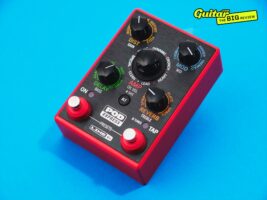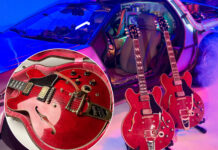
Line 6 POD Express review: could this minimal modeller be all you need?
$179/£185, line6.com
The original Line 6 POD launched approximately two billion years ago, all the way back in 1999. At the time it was basically the only legitimate option for (relatively) high quality, digitally-modelled direct guitar sounds. Whereas in 2024, you’ve got more options than you can shake an impulse response at – 25 years of innovation has, along with better sounds, also given us more products with more screens, more features, more MIDI, more effects, more amps, more proprietary cabinet-sim technology, more ins and outs and more apps.
READ MORE: Line 6 HX One review – does it deserve a place on every guitarist’s pedalboard?
This is all well and good if you need all of that stuff, but let’s be honest, there are a lot of people who don’t. Enter the Line 6 POD Express, which, with its size and lack of screen, attempts to streamline digital guitar tones back down into a simple, easy-to-use and inexpensive product – no MIDI, no screen, no app, just sounds. But can such a minimalist approach work in 2024?
What is the Line 6 POD Express?
Photo by Adam Gasson / Guitar.com
The trend of straightforward, compact amp-modelling pedals is nothing new. The Strymon Iridium, the Walrus ACS-1 and the UAFX amp pedal range all cram digital amps into pedal-sized things, and don’t bother with comprehensive effects libraries or the kind of in-depth control a “full” multi-effects unit like the HX Stomp can offer.
What is new is how the Line 6 POD Express applies that screenless, straightforward approach to, well, that full multi-effects experience. Like the recent Boss IR-2, it brings a full library of amp styles to the table, spanning the cleanest cleans to the highest of gains. But unlike the IR-2, there’s also a bunch of on-board effects, including ping-pong delays, ambient reverb, flangers, phasers, drives and fuzz.
Given the price tag and plastic case here, the sights are clearly set more towards the entry-level end of the market – the IR-2, with its stereo effects loop, user-loadable IRs and ever-so-Boss utilitarian design was clearly gunning for a slot within a larger direct rig. The POD Express could feasibly provide a beginner with all they need to get playing – no amp or pedals required.
But… haven’t we danced this dance before? The Zoom G2 Four was an entry-level plastic multi-effects unit, one that also aimed to be both pedalboard and amp for a similar-ish price. Its hubris saw it impaled on the lowest review score we’ve given in years. Can the Line 6 POD express avoid the same fate?
UX design in plastic, it’s fantastic
Photo by Adam Gasson / Guitar.com
Plucking the POD out of the packaging, powering it up and proceeding to plug in and play is a pretty painless process. It takes three AAs (included) or a 9V centre-negative 500mA supply (not included), and once you’re connected you have the option of either two quarter-inch line-outs or a standard headphone jack. You can also connect the POD Express to a computer via USB-C for either recording without an extra interface, or for playing along to your own music.
Given that the user interface is both screenless and very much not what-you-see-is-what-you-get, I’m pleasantly surprised to find it as intuitive as I do once I get going. I didn’t have to consult the manual once to get a handle on the basic operation. For something with this much going on and no screen, that’s a good sign.
How it works is this: the ‘display’ is a set of multi-colour LEDs that encircle the central rotary switch. When left alone, this will mark which of the seven amplifier models you currently have selected – or not shine at all, if you’ve bypassed the amp. Alternatively, when in preset selection mode, each bank is represented by a colour. A preset is saved to ‘clean’ with white LEDs, or to ‘crunch’ with blue LEDs and so on.
The presets can be scrolled through with the encoder or the two footswitches – making it surprisingly viable for live usage. Similarly, the LEDs are nice and bright, and the circle display is inherently readable at a distance. And despite being someone who loves to complain about how guitar products often forget colourblindness is a thing, I won’t be doing so today. The colours that demarcate the preset banks are white, blue and orange – three easily distinguishable shades, even for me. Whether or not that was deliberate, it’s still good to see. Literally.
The four control knobs have their travel portioned up into different variations of their effects, as you might find on slightly older digital modelling amps – between zero and 25% on a knob is one effect, then 25% to 50% is another, and so on. This can occasionally make for fiddly adjustment, but upon turning an effect knob the central circle display fills up between zero and 100% to give you an accurate read on what you’re dialling in. Despite there only being seven LEDs, the last one on the bar will gradually vary its brightness to indicate a finer level of detail. The same happens when you hold down the ‘alt’ button to adjust the amp model’s EQ, volume and gain.
This may all sound very complicated, but trust me it’s really quite easy to get used to, and one of the more elegant ways I’ve seen of burying non-persistent settings behind physical knob positions, without using a screen, or, heaven forfend, an app on your phone.
Does the Line 6 POD Express sound good?
Line 6 Pod ExpressPhoto by Adam Gasson / Guitar.com
Line 6 is obviously incredibly well-versed in amp and effects modelling at this point, and that experience shows – I find a good sound very, very easy to dial in here. The clean tones could maybe do with a compressor, but in lieu of that, the Special amp model with a bit of a boost engaged does give a nice and squishy ‘pushed clean’ sound. The Chime model gives a pleasingly vocal, raspy honk when combined with the virtual fuzz, which itself actually sounds like a fuzz – a rarity on digital gear!
Moving up to the higher-gain end of the spectrum, Crunch, Heavy and Lead all offer lots of saturation. Crunch is more suited to boosting with a virtual overdrive for a metal rhythm sound, whereas Heavy and Lead are gainy enough for some satisfying, smooth solo tones.
I’m pleased to report a complete lack of fizz on the high-gain models. Sure, you can get things to sound nasty if you crank the treble too high, but even doing that there’s none of that blatantly artificial top-end crackle that can spell doom for a direct high-gain tone.
The time-based and modulation effects are all good too – there’s stereo width applied to basically everything, which actually goes a long way to adding some breathing room when playing with headphones and preventing ear fatigue. The modulation settings aren’t going to win any awards for perfect digital recreations of analogue gear, but they all do a good job of adding their particular flavour of swoosh.
Even on the more overtly ambient side of things, the POD provides the goods. The Ping Pong delay is great fun, and the Space reverb goes almost full wet for the sort of utterly washed-out bliss that’ll please the P&W players as much as those looking to soundtrack an Interstellar fan film.
Bass players rejoice!
Photo by Adam Gasson / Guitar.com
Despite our normal remit being the six-string realm, I think it’s worth noting that I also took a look at the bass version of the POD Express. My assessment of it is pretty much identical to what I have to say about the guitar version, because other than a different set of amp models and effects, it’s the same hardware. All of the amp models sound good, and the various compressor effects are a welcome addition for dialling in a good bass sound.
It’s nothing groundbreaking, but the existence of the thing in itself is good – bassists have rightfully bemoaned the absence of any low-end focus from previous launches of pedals in this vein, including that of the IR-2. The bass version being its own dedicated version of the pedal with bass-specific amps and effects is great news for beginner bassists, or those who want a giggable direct rig on a budget.
Is the Line 6 POD Express worth it?
Line 6 Pod ExpressPhoto by Adam Gasson / Guitar.com
As much as it pains me, it is time once again to think about the Zoom G2 Four. Because, in being shaped vaguely like an HX Stomp, the G2 Four promised a full multi-effects experience. An affordable take on one, but a full experience nonetheless – there was a screen for on-device deep editing, and a big ol’ library of effects and amps.
However, thanks to woefully underpowered hardware, that experience was completely kneecapped – the editing was far too in-depth for beginners, far too limited for more experienced players, and a slow and unresponsive UX disaster no matter who you were. Creating a new sound required Olympian levels of patience and lots of trial and error.
The POD Express, on the other hand, demonstrates what you can actually get away with trimming the fat to make a product more affordable, while still making something that’s usable and great sounding. The Express moniker is earned, as sound-shaping takes effectively no time at all. Want a delay? Turn the delay knob until it sounds good. You don’t have to enter patch-editing mode, pick an effect from a menu, and place it where you want it to go.
What’s more, the features it has stripped away are not going to be missed by the vast majority of people who are going to be interested in buying it, while creating a more streamlined path from, ‘Oh, I would like my guitar to sound like this’, to it actually sounding like that.
Photo by Adam Gasson / Guitar.com
And even saying all of the above, it’s worth noting that the thing still keeps pace with some of the more pro-feeling and looking gear out there in a number of ways. The sounds are good – they might not be up to the studio-quality tones you get from a more expensive modeller, but I wouldn’t bet on a live audience being able to tell that you’re not using a pricier piece of kit.
And speaking of live usage, you can even add a dual footswitch to turn two effects of your choice on or off – it’s good to see something like this not totally abandon the idea of performance for the sake of practice functionality.
Overall, I think that the POD Express has set out a very specific goal for itself – and then pinged a screamer straight into the back of the aforementioned net. It’s a great example of how to strip a guitar product down to the actual essentials, with user experience taking centre stage. The reality is, if you need a more versatile, professional piece of kit where you can move effects blocks about and adjust delay times by the millisecond, you’re unlikely to be shopping for a sub-£200 multi-effects. But if you are shopping in this world? Then the POD Express is seriously impressive.
Line 6 POD Express Alternatives
As is often the case, what makes a viable alternative here will depend on what you want from a product like this. If you want something for home practice with a similar set of amps and effects, but would like to easily play out loud, the Positive Grid Spark Go ($/£129) or Mini ($/£229) will offer a similar experience but with a speaker thrown in. If you don’t care about effects and just want to go direct with a good amp sound, the Boss IR-2 ($199/£179) is a great way of doing just that. The UAFX amp pedals ($399/£349) are excellent digital models (even if their UX could take a leaf out of the POD Express’ book) – but they’re also more than twice the price, for pedals with technically far fewer features. It’s up to you as to whether the fidelity of their vintage amp captures makes that worth it.
The post Line 6 POD Express review: could this minimal modeller be all you need? appeared first on Guitar.com | All Things Guitar.
Source: www.guitar-bass.net












